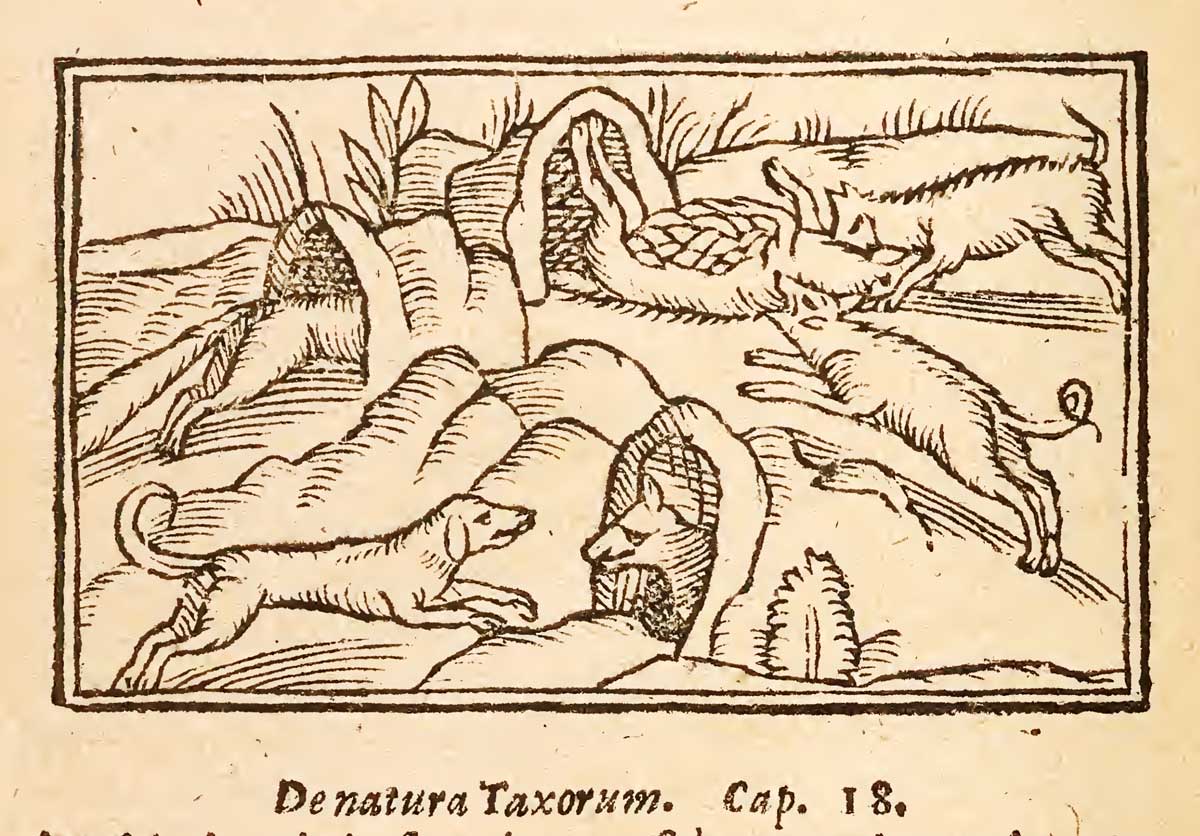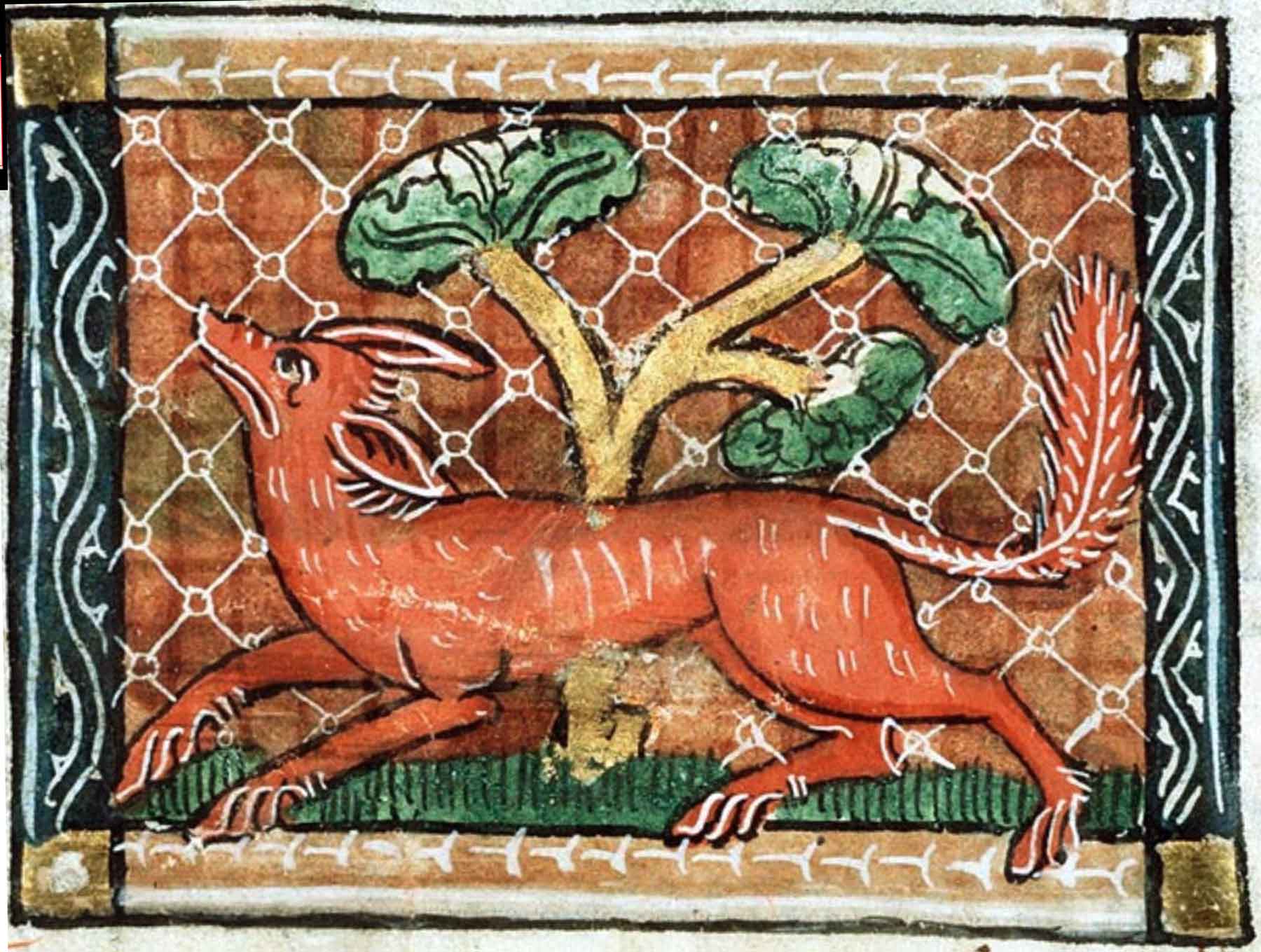alopecuros, which resembles the tail of a fox;
Original French: Alopecuros, qui ſemble a la queue de Renard:
Modern French: Alopecuros, qui semble à la queue de Renard:
Among the plants named by similitude.
Notes
Volpes
Fox

The woodcut doesn’t depict fox tails, but the tails of dogs harrying them in their dens.
Alopecuros
An example of the plants which have a spike is the plant which some call ‘dog’s eye’ (rib-grass), which comprises several forms; we have also ‘foxbrush,’ stelephuros (plantain), which some call ‘lamb’s tongue’ and some ‘quail-plant’; and somewhat similar to this is thryallis. These are simple plants and uniform in character, having a spike which is not pointed nor bearded; while in ‘fox-brush’ it is soft and somewhat downy, in that it actually resembles the brush of a fox, whence also it has obtained its name. Similar to this is stelephuros (plantain), except that it does not, like that plant, flower here and there, but all up the spike like wheat.
Alopecuros
Aliud rursus spicatarum genus, ex quo est achynops, alopecuros, stelephuros,—quam quidam ortygem vocant, alii plantaginem, de qua plura dicemus inter medicas—, thryallis. ex his alopecuros spicam habet mollem et lanuginem densam non dissimilem vulpium caudis, unde et nomen. proxuma ei est et stelephuros, nisi quod illa particulatim floret. cichorion et similia circa terram folia habent germinantia ab radice post vergilias.
Eared plants are yet another kind, to which belong achynops, alopecuros, stelephuros—by some called ortyx, by others plantago, about which I shall speak more fully in the section on medicinal plants—and thryallis. Of these alopecurus has a soft ear and thick down, not unlike the tail of a fox [Alopecurus = fox-tail]; hence too its name. Stelephuros is very like it, except that it blossoms bit by bit. Chicory and the plants like it have leaves near the ground, budding from the root after the Pleiades.
alopecuros
D’ἀλώπηξ, renard, et οὐρά, queue.
Alopecuros
Pliny xxi. 17, § 61.
alopecuros
Αλωπεχουροζ (Théophraste, H.P., VII, 10) — de αλωπηξ, renard, ουρα, queu; allusion à la forme de l’épi. « Spicam habet mollem et lanuginem densam, non dissimilem vulpium caudis ». Pline, XXI, 61. Il s’agit évidemment d’une graminée : Saccharum cylindricum, Lmk? si on l’interprète comme Dalechamps, ou Polypogon monspelliense, Desf.? pour Fée. Pena et Lobel appellent Αλωπεχονροζ Theophrasti et Cauda vulpis Monspellliensium notre Lagurus ovatis, L. — Le nom d’Alopecurus désigne aujourd’hui un autre g. de Graminées, le Vulpin.
alopecuros
thus alopecuros or foxtail grass…
pas similitude
Toutes ces plantes, dans De latinis nominibus, sauf pour le delphinium.
Alopecuros
De ἀλωπήξ, «renard», et οὐφά, «queue» (Pline, XXI, lxi).
alopecia
alopecia. [Latin alopecia, adopted from Greek alwpeki a fox-mange, also baldness in man, formed on alwphc a fox.]
A medical term for baldness.
1398 John de Trevisa Bartholomeus De proprietatibus rerus v. lxvi. (1495) 184 By that euyll callyd Allopicina nourysshynge of heer is corrupte and fayllyth, and the fore party of the heed is bare, suche men fare as foxes.
1585 Lloyd Treas. Health B viij, Burne the heade of a great Ratte and myngle it wyth the droppynge of a Beare or of a hogge and anointe the head, it heleth the desease called Allopecia.
